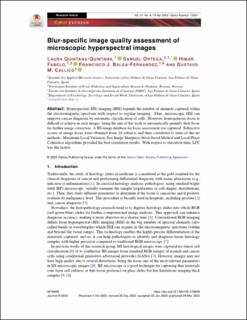| dc.contributor.author | Quintana, Laura | |
| dc.contributor.author | Ortega, Samuel | |
| dc.contributor.author | Fabelo, Himar | |
| dc.contributor.author | Balea-Fernández, Francisco J. | |
| dc.contributor.author | Callico, Gustavo M. | |
| dc.date.accessioned | 2023-04-11T07:47:53Z | |
| dc.date.available | 2023-04-11T07:47:53Z | |
| dc.date.created | 2023-03-30T11:50:35Z | |
| dc.date.issued | 2023 | |
| dc.identifier.citation | Optics Express. 2023, 31 (8), 1-19. | |
| dc.identifier.issn | 1094-4087 | |
| dc.identifier.uri | https://hdl.handle.net/11250/3062263 | |
| dc.description.abstract | Hyperspectral (HS) imaging (HSI) expands the number of channels captured within the electromagnetic spectrum with respect to regular imaging. Thus, microscopic HSI can improve cancer diagnosis by automatic classification of cells. However, homogeneous focus is difficult to achieve in such images, being the aim of this work to automatically quantify their focus for further image correction. A HS image database for focus assessment was captured. Subjective scores of image focus were obtained from 24 subjects and then correlated to state-of-the-art methods. Maximum Local Variation, Fast Image Sharpness block-based Method and Local Phase Coherence algorithms provided the best correlation results. With respect to execution time, LPC was the fastest | |
| dc.description.abstract | Blur-specific image quality assessment of microscopic hyperspectral images | |
| dc.language.iso | eng | |
| dc.title | Blur-specific image quality assessment of microscopic hyperspectral images | |
| dc.title.alternative | Blur-specific image quality assessment of microscopic hyperspectral images | |
| dc.type | Peer reviewed | |
| dc.type | Journal article | |
| dc.description.version | publishedVersion | |
| dc.source.pagenumber | 1-19 | |
| dc.source.volume | 31 | |
| dc.source.journal | Optics Express | |
| dc.source.issue | 8 | |
| dc.identifier.doi | 10.1364/OE.476949 | |
| dc.identifier.cristin | 2138456 | |
| cristin.ispublished | true | |
| cristin.fulltext | original | |
| cristin.qualitycode | 2 | |
